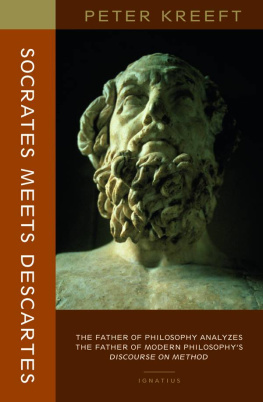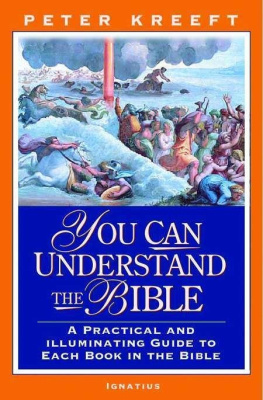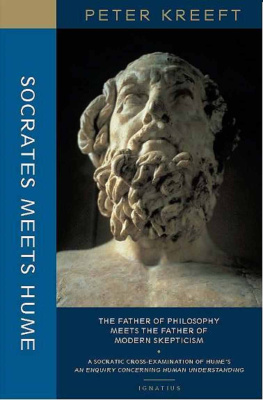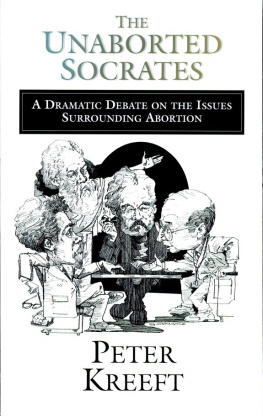DOORS IN THE WALLS
OF THE WORLD
PETER KREEFT
Doors in the
Walls of the World
Signs of Transcendence
in the Human Story
IGNATIUS PRESS SAN FRANCISCO
Unless otherwise indicated, Scripture quotations are from the Revised Standard Version of the BibleSecond Catholic Edition (Ignatius Edition) copyright 2006 National Council of the Churches of Christ in the United States of America. All rights reserved worldwide.
Composite cover art:
Path through a Misty Forest
iStock.com/Sjoerd van der Wal
Old Door
iStock.com/Samiylenko
Cover design by
Enrique J. Aguilar
2018 by Ignatius Press, San Francisco
All rights reserved
ISBN 978-1-58617-228-2 (PB)
ISBN 978-1-68149-801-0 (EB)
Library of Congress Control Number 2018931254
Printed in the United States of America
Contents
INTRODUCTION
Three Philosophies of Life
How many possible philosophies of life are there?
Answer #1: In the beginning, there is only one philosophy of life. For all authentic philosophy begins in wonder. All three of the founders of philosophy, Socrates, Plato, and Aristotle, said that philosophy begins in wonder.
But there are three kinds of wonder:
1. Wonder begins in surprise . This is wonder in the emotions. We go on to questioning wonder, which is the second kind of wonder, only when something surprises us or strikes uswhen the seas of our emotions are troubled by something thrown into them unexpectedly from outside: a stone, an angel, or Mosessomething that parts our inner Red Sea, which is our heart. Our why (wonder #2, questioning wonder) is provoked by our wow (wonder #1, emotional wonder). I do not wonder why another student comes through my classroom door, but I do wonder why a gorilla comes through.
2. This second kind of wonderquestioningis wonder in the intellect, guided by the will (the will to truth, which is far from automatic). When we are surprised, we then wonder about the what and the why of the surprise. We wonder (#2) about the wonder (#1).
3. Wonder is consummated in contemplative awe. This is wonder in the deepest heart. We marvel at the truths we have understood: at the design of a mosquito under a microscope, of the order of the physical universe under the mental microscope of a mathematician, and above all at ourselves, at our good and at our evil, under the moral microscope of conscience and that most dangerous and wonderful of spiritual adventures, absolute honesty.
Philosophy not only begins in wonder (#1), it also proceeds by means of wonder (#2) and ends in wonder (#3).
This book is about the third kind of wonder.
Answer #2: When you think about it logically, there are two and only two philosophies of life. For either there are or there are not doors in the walls of the world. Either there is Nothing or Something outside Platos Cave.
That sounds very abstract and philosophical. Let me make it very concrete.
Two people are walking down a street together. There is an old stone wall on their left, too high to see over. As they approach an intersection, the sidewalk and the wall curve around to their left. As they approach the curve, the first walker is absolutely certain that when they turn the corner they will not see an angel walking through the wall. The second walker is not.
Which walker are you?
Which would you like to be?
A wall is a limit. A door in a wall is a way of overcoming that limit, a way out of the place confined by the walls. The walls here symbolize the physical universe. The doors symbolize escapes from that limit, morenesses, transcendences. The point of this book is that there are many doors through the walls of the world, many Jacobs Ladders through the sky.
The most famous passage in all of philosophy, at the heart of the Republic , is Platos Cave. In this myth (myth means sacred story), Plato says that we are all born into a little, dark cave. The cave is the mind that sees only appearances and does not question what they are the appearances of. We are prisoners there, and our necks are chained so that we cannot turn them around, and all we see are shadows on the walls in front of us, and we think that is all there is. But there is much more; and the point of philosophy, for Plato, is to unchain our necks so that we can see the more. The shadows on the walls of the cave are real, but they are only real appearances that are cast by more-real, more-solid things. At first we do not see these things because they are behind our backs. And there is still more: these things cast shadows only because there is a fire in the cave that makes the light, but we dont see that, either, because we cant turn our necks around; so we just take the firelight for granted. Finally, there is a road that leads out of the cave into a whole other, larger world outside. But we dont believe it leads anywhere, and besides, its a hard road to travel, being narrow and rocky. But if we do turn our necks around and see that there is more even in the cave (that seeing is what physical science does), we might wonder what is outside the cave (that wondering is what philosophy does) and actually escape.
We ourselves are the prisoners, and the walls of the cave are time and space and matter. The things we see in the material world are real, but they not only have shadows (on the cave walls) but also themselves are only shadows of something more. They are the epidermis of reality, like the surface of the sea, the surf-face. Platos point is that what we see is relative to what we do not see, as shadows are the shadows of , and relative to, something more real, more absolute, than themselves. There are not only more things in heaven and earth than we dream of in our philosophies, but there are more kinds of things than we dream of.
In fact, there are more things than just things . There are, according to Plato, also essences, the natures of things, such as Justice Itself or Beauty Itself or Humanness Itself. The beauty of a womans face is relative to Beauty Itself, and not, as we usually think, vice versa. The justice of a righteous act is relative to Justice Itself, and not vice versa. A human is relative to and judged by his humanness, not vice versa. Material things are changeable, and our ideas are fallible. Our ideas of beauty and justice and humanity may be wrong; they are mere subjective ideas, mere opinions in our minds, and they are relative to the objective material realities we see; but the Platonic Ideas are not ideas but Ideas, not subjective opinions but objective immaterial realities, the absolutes to which both material things and our ideas are relative. That is why our subjective opinions and material things can match: because they match the same things, the Ideas or Essences or Forms. The same Justice exists both in a just law and in a true idea of the justice of a just law; that is why the idea can be true. Both things and thoughts (ideas) participate in the same Idea.
So there are not just one or even two but three worlds or kinds of reality: objective material things, subjective ideas, and absolute, timeless objective Ideas, Truths, Essences, or Forms. (Forms, whats, not just shapes.) Material forms (shapes) are in both space and time. Our subjective ideas are not in space, as material things are, but they are in time; we change our minds as often as we change our clothes. But Platonic Ideas are timeless as well as spaceless. Wisdom consists in knowing them.
Materialism says that life is not really a play at all, but a chaos on which we impose subjective order by inventing a play. In other words, that life is full of sound and fury, signifying nothing. The meaning of life is nothing; there is merely the meaning of matter.
Answer #3: We have seen that in one sense (Answer #1) there is only one philosophy of life (wonder) and that in another sense (Answer #2) there are two (materialism and spiritualism). We can also say that there are three philosophies of life. Lets call them moreness, lessness, and sameness. For either there are more things or fewer things or the same things in heaven and earth (i.e., in objective reality) as the things dreamed of in our philosophies (i.e., in our subjective ideas). We could also call these three philosophies mysticism (there is more), reductionism (there is less), and rationalism (there is the same). No one of the three has ever been proved or disproved to everyones satisfaction by science, logic, or the events of history. That is why you still meet people who believe all three of them.
Next page














